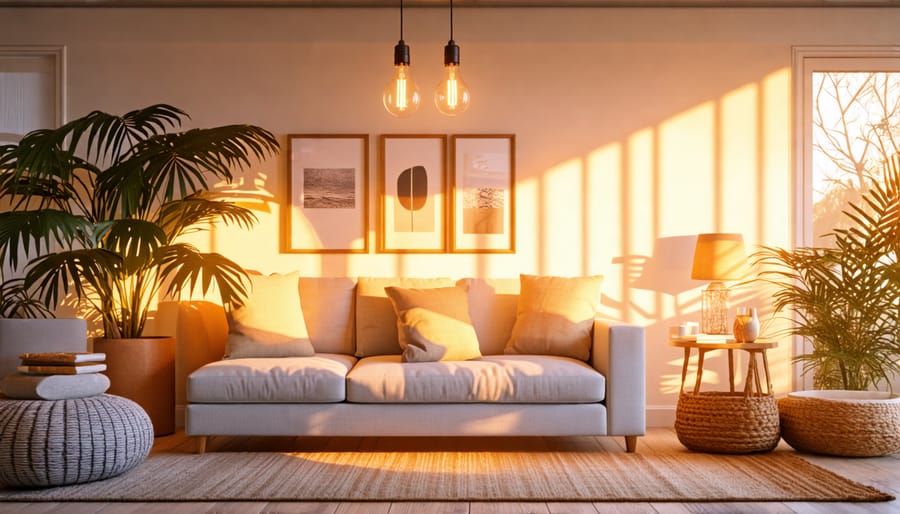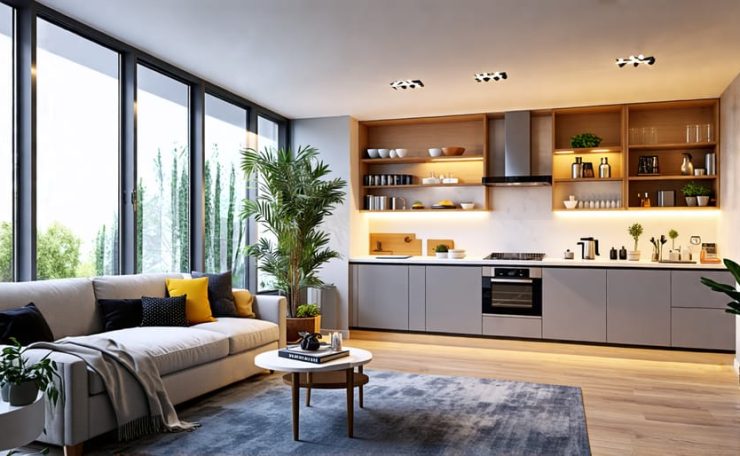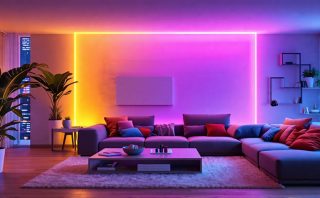Assess the functional and aesthetic requirements of the space by consulting Lutron’s Lighting Trend Report, which reveals homeowners’ lighting preferences. Consider color temperature: warm white (2700-3000K) creates a cozy ambiance; cool white (4000K+) energizes and brightens. Evaluate the Color Rendering Index (CRI): aim for 90+ to accurately represent colors. Mix color temperatures thoughtfully, using warm white for relaxation areas and cool white for task-oriented spaces.
Matching Light Bulb Color to Room Function
Living Rooms and Bedrooms
For living rooms and bedrooms, warm white light bulbs ranging from 2700K to 3000K are the ideal choice to create a cozy and relaxing ambiance. These warm tones enhance skin tones, making people appear more attractive and inviting, which is perfect for spaces where you want to unwind and feel comfortable. The soft, golden glow of warm white light bulbs can make your living room feel more inviting for family gatherings or intimate conversations with friends. In bedrooms, the soothing qualities of warm white light promote a sense of calm and relaxation, helping you to wind down at the end of a long day and prepare for a restful night’s sleep. By selecting warm white light bulbs for these spaces, you can transform your living room and bedroom into inviting sanctuaries that offer a respite from the stresses of daily life.

Kitchens and Bathrooms
When it comes to kitchens and bathrooms, cool white light bulbs are an excellent choice. With color temperatures ranging from 4000K to 6500K, these bulbs emit a bright, crisp light that closely mimics natural daylight. This invigorating illumination is perfect for tasks that require visual clarity, such as cooking, cleaning, applying makeup, or shaving. The clean, cool light helps you see colors accurately and spot even the smallest details, ensuring that you can complete your tasks efficiently and effectively. Additionally, the energizing quality of cool white light can help you feel more alert and awake, making it an ideal option for busy mornings or late-night cleaning sessions. By installing cool white light bulbs in your kitchen and bathroom, you can create a functional and refreshing atmosphere that supports your daily routines and enhances the overall ambiance of these essential spaces.
Home Offices and Study Spaces
For home offices and study spaces, daylight bulbs are the ideal choice to boost alertness, reduce eye strain, and improve productivity. These bulbs emit a cool, bright light that mimics natural daylight, helping to keep you focused and energized throughout the day. The high color temperature of daylight bulbs, typically ranging from 5000K to 6500K, provides a crisp, clear illumination that enhances visual acuity and color perception. This is particularly beneficial when working on tasks that require attention to detail, such as reading, writing, or analyzing data. By creating a well-lit environment that minimizes shadows and glare, daylight bulbs can help prevent headaches and fatigue associated with prolonged screen time or poor lighting conditions. Incorporating daylight bulbs in your home office or study space can significantly improve your overall comfort and efficiency, making it easier to stay on task and maintain a positive, productive mindset.
Dining Rooms and Entertaining Areas
For dining rooms and entertaining areas, a mix of warm and cool lighting creates a dynamic, inviting atmosphere perfect for socializing. Warm light sources, such as soft white or warm white bulbs, provide a cozy and intimate ambiance that encourages conversation and relaxation. These warm tones are ideal for accent lighting, such as wall sconces or pendant lights above the dining table. On the other hand, incorporating cool white light sources, like daylight bulbs, in recessed ceiling fixtures or floor lamps can add a touch of sophistication and help balance the overall lighting scheme. This combination of warm and cool lighting allows for flexibility in setting the mood, from casual family dinners to elegant dinner parties. By strategically placing and layering these different light temperatures, you can create a visually appealing and comfortable space that adapts to various social occasions and enhances the dining experience for your guests.
Combining Colors for Layered Lighting
Accent Lighting
Accent lighting provides an excellent opportunity to create visual interest and depth by incorporating contrasting color temperatures. While the primary lighting in a room may feature a warm or neutral color temperature, accent lights can introduce cooler tones to highlight specific focal points. For example, using a cool white (4000-5000K) LED spotlight to illuminate a piece of artwork against a wall lit by warm white (2700-3000K) under cabinet lighting can create a striking contrast that draws the eye to the desired area. Similarly, combining warm and cool color temperatures in cove lighting or shelf lighting can add depth and dimension to a room’s overall ambiance. When selecting accent lighting, consider the colors and materials of the objects being highlighted to ensure the chosen color temperature enhances rather than detracts from their appearance.
Dimmer Switches
Dimmer switches offer a versatile solution for adjusting the color temperature of your lighting to suit changing needs and moods throughout the day. By controlling the brightness of your bulbs, dimmers allow you to create a warm, cozy ambiance for relaxation or a bright, energizing atmosphere for productivity. This flexibility is especially useful in multi-purpose spaces like living rooms or home offices, where lighting requirements may vary depending on the activity or time of day. Additionally, AI’s role in lighting controls is expanding the capabilities of dimmer switches, enabling even more precise and personalized control over your lighting’s color temperature. By investing in dimmer switches, you can effortlessly adjust your lighting to complement your mood, task, or occasion, making them an essential tool for optimizing the color temperature of your space.
Consulting with Lighting Professionals
While selecting the right light bulb color may seem straightforward, complex lighting projects often benefit from the expertise of lighting professionals. These experts possess in-depth knowledge of color temperature, illumination levels, and the psychological impact of various lighting schemes. They can help you navigate the vast array of options and create a customized lighting plan that optimizes functionality, aesthetics, and energy efficiency for your specific space.
Engaging a lighting consultant is particularly valuable for large-scale projects, such as commercial buildings, event venues, or high-end residential properties. These professionals can conduct a thorough assessment of your space, taking into account factors like room size, intended use, natural light sources, and desired ambiance. Based on their analysis, they can recommend the ideal combination of light bulb colors, fixtures, and placement to achieve your desired outcomes.
Moreover, lighting professionals stay up-to-date with the latest industry trends, technological advancements, and energy-saving solutions. They can introduce you to innovative products and techniques that you may not have considered, helping you create a cutting-edge lighting design that sets your space apart. By leveraging their expertise, you can ensure that your lighting project is executed flawlessly, maximizing the potential of your space and creating an inviting atmosphere that leaves a lasting impression on all who experience it.





